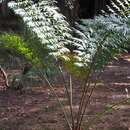Comments
provided by eFloras
This recently described species is most similar to Cycas multipinnata in its 3-pinnate leaf structure, but differs in its more numerous and much shorter leaves, with segments long
attenuate or long acuminate at the apex; its megasporophylls, with subcordate or subflabellate, wider sterile blades divided into 39-51 filiform lobes; and its dry and sunny habitat.
Unfortunately, this cycad is one of the most endangered in China, restricted to a very small area (ca. 20 ha) in a village, and will become extinct in the wild within the next ten years
unless conservation measures are implemented.
- license
- cc-by-nc-sa-3.0
- copyright
- Missouri Botanical Garden, 4344 Shaw Boulevard, St. Louis, MO, 63110 USA
Description
provided by eFloras
Trunk almost subterranean, to 40(-70) × 25(-40) cm above ground, sometimes clumped; bark brown-gray, scaly toward apex of trunk, subsmooth toward base. Leaves (3-)5-11(-15), 3-pinnate, ovate in outline, ± openly "V"-shaped in cross section at 110-150° between leaflets, 1.3-2.7 × 0.5-1.5 m; petiole obovate-orbicular in cross section, 0.6-1.3 m × 1.5-3 cm, tomentose when young, later glabrescent except at base, spiny except at base; spines 20-55 along adaxial part of each side, 1-4.5 cm apart, conical, 3-4 mm; primary leaflets in 6-14 pairs, 3-12 cm apart, middle leaflets subopposite, longest, 40-70 × 20-27 cm, "V"-shaped in cross section at 70-90° between secondary leaflets, basal and apical leaflets alternate, gradually smaller toward base and apex of leaf blade, 17-50 × 10-23 cm; secondary leaflets in 3-5 pairs, ovate to obtriangular, dichotomously 2- or 3-forked, 12-25 × 4-15 cm, with petiolule 0.5-2 cm; segments (ultimate leaflets) 3-5, green and shiny above, light green below, linear, 10-22(-28) × 0.8-1.5 cm, thickly papery, glabrous, midvein raised on both surfaces, base decurrent, margin flat or somewhat undulate, apex long attenuate or long acuminate. Cataphylls triangular, 6-8 × 2.5-3 cm, densely brown tomentose, apex acuminate, somewhat soft. Pollen cones ovoid and brown tomentose initially, fusiform-cylindric and glabrescent at maturity, 13-25 × 4-9 cm; microsporophylls narrowly cuneate, 3-3.5 × 1.2-1.6 cm, apical sterile part semiorbicular, slightly revolute, apex broadly rounded with short, upcurved mucro. Megasporophylls 30-50, laxly grouped, 15-20 cm, yellow-brown tomentose, forming an oblate group 18-25 cm in diam.; stalk 9-12 cm; sterile blade green, subcordate or subflabellate, 6-9 × 5-10 cm, glabrescent, deeply divided into 39-51 filiform lobes 3-6 cm, terminal lobe 4-5 cm; ovules 2 or 3 on each side of stalk, glabrous. Seeds 3 or 4, green to yellowish and brown, subglobose or obovoid-globose, slightly compressed, 3-3.5 × 2.5-3 cm, apex mucronate; sclerotesta finely verrucose. Pollination Mar-Apr, seed maturity Nov.
- license
- cc-by-nc-sa-3.0
- copyright
- Missouri Botanical Garden, 4344 Shaw Boulevard, St. Louis, MO, 63110 USA
Habitat
provided by eFloras
* Thickets and sparse forests of small trees on dry, sunny, open slopes of limestone hills; 700-1000 m.
- license
- cc-by-nc-sa-3.0
- copyright
- Missouri Botanical Garden, 4344 Shaw Boulevard, St. Louis, MO, 63110 USA
Cycas debaoensis: Brief Summary
provided by wikipedia EN
Cycas debaoensis is a plant species endemic to the Guangxi region of China. It grows in sunny locations at elevations of 700–1000 m. It is closely related to Cycas multipinnata.
- license
- cc-by-sa-3.0
- copyright
- Wikipedia authors and editors

